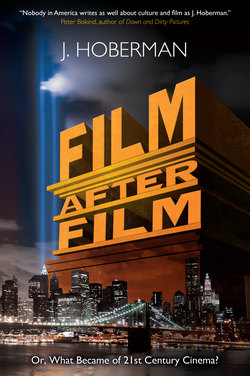Читать книгу Film After Film - J. Hoberman - Страница 7
На сайте Литреса книга снята с продажи.
ОглавлениеCHAPTER ONE
THE MYTH OF “THE MYTH
OF TOTAL CINEMA”
Can we speak of a twenty-first-century cinema? And if so, on what basis?1
In the immediate aftermath of World War II, the French film critic André Bazin offered a narrative in opposition to a then current notion that cinema developed in the spirit of scientific inquiry. Bazin characterized cinema as an idealistic phenomenon and cinema-making as an intrinsically irrational enterprise—namely, the obsessive quest for that complete representation of reality that he termed Total Cinema.
“There was not a single inventor who did not try to combine sound and relief with animation of the image,” Bazin maintained in “The Myth of Total Cinema.” Each and every new technological development—synchronous sound, full-color, stereoscopic or 3-D movies, Smell-O-Vision—served to take the cinema nearer to its imagined essence, which is to say that “cinema has not yet been invented!” Moreover, once true cinema was achieved, the medium itself would disappear—just like the state under true communism. Writing in 1946, Bazin believed that this could happen by 2000. In fact, something else occurred: the development of digital computer-generated imagery (CGI) broke the special relationship that existed between photography and the world.
The Myth of Total Cinema, the “recreation of the world in its own image,” was for Bazin a factor of cinema’s essence: the medium’s integral realism was predicated on the camera’s impartial gaze (the French word for lens is objectif), as well as the chemical reaction by which light left an authentic trace on photographic emulsion. In “The Ontology of the Photographic Image,” an essay published in 1945, Bazin had noted that “photography affects us like a phenomenon in nature … The photograph as such and the object in itself share a common being.” Because of this impartial, indexical connection between the photograph and that which was photographed (the profilmic subject or event), motion pictures produced an all-but-automatic image “unburdened” by artistic interpretation. Like a shadow or a bullet hole, a photograph was a form of evidence—a “hallucination that is also a fact.” Moreover, each photograph was derived from its own material evidence in the form of the negative image produced by the initial photo-chemical reaction. Such negatives might be altered, cropped in the course of printing, or even destroyed but, at least initially, the image existed as a recognizable physical entity—unlike the infinitely malleable binary code produced, however indexically, by a digital camera.2
The divorce between photography and the world was initially experienced as a crisis in photography. Thanks to Photoshop, the image editing program first introduced in 1990, as well as other forms of digital manipulation, the photographic became an element or subset of the graphic. Previously, as art historian Julian Stallabrass observed in the mid 1990s, “forging ordinary photographs involved great skill and, if all variants and the original negatives were not destroyed, could always be unmasked.” Digitalization, which made image manipulation easily accessible, was “a technique which lends itself to the production of useful lies.” Photography might retain “its powers of resemblance,” but it would lose “its veracity.”3
As the digitally manipulable photograph superseded the world as raw material for image-making, the existential crisis for motion pictures was even more intense: Bazin had imagined cinema as the objective “recreation of the world.” Yet digital image-making precludes the necessity of having the world, or even a really existing subject, before the camera—let alone the need for a camera. Photography had been superseded, if not the desire to produce images that moved. Chaplin was perhaps but a footnote to Mickey Mouse; what were The Birth of a Nation and Battleship Potemkin compared to Toy Story 3? With the advent of CGI, the history of motion pictures was now, in effect, the history of animation.4
